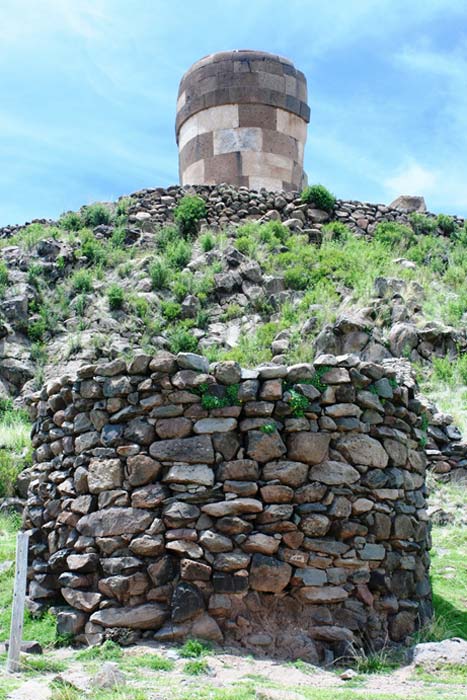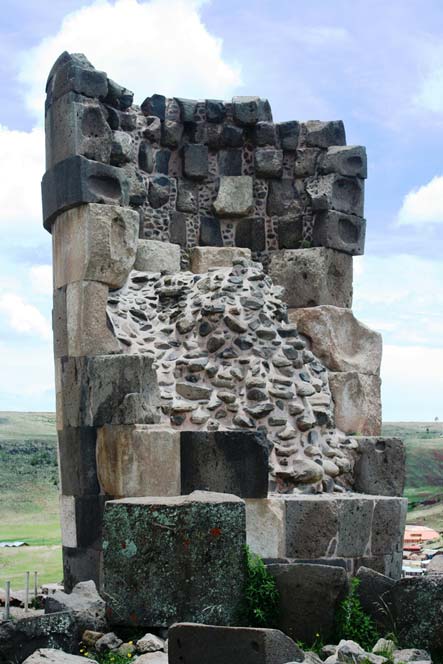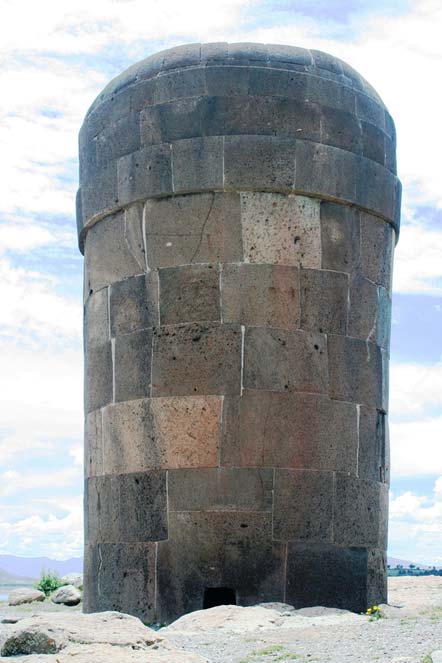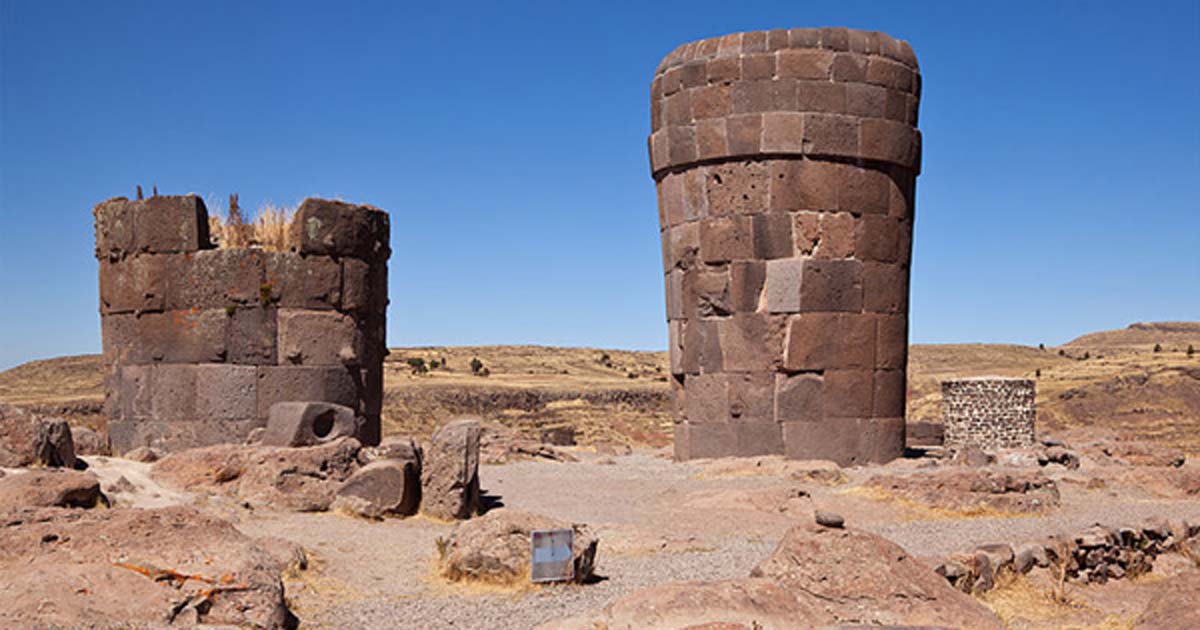Were the Ancient Funerary Towers of Sillustani Peru Originally Part of an Energy System?
Sillustani is a pre-Incan burial ground on the shores of Lake Umayo, about an hour’s drive from Puno in Peru, which is a large city on the shore of Lake Titicaca. The tombs, which are built above ground in tower-like structures called chullpa, are the vestiges of the Colla people, Aymara speaking people who were conquered by the Inca in the 15th century. The structures housed the remains of complete family groups, although they were probably limited to nobility. Many of the tombs have been dynamited by grave robbers, while others were left unfinished.
The above is the conventional rhetoric espoused by academics, and is the information which most guides to the Sillustani site give visitors. What they generally believe is that the smaller and cruder chullpa were created first, by the Colla people between 1200 and 1400 AD and that the Inca, who conquered the Colla during the 15 th century constructed the larger and more precise ones afterwards.
Prior to the Colla, the great Tiwanku civilization, whose name sake is a prominent archaeological site just south of the shore of Lake Titicaca in Bolivia, held sway to some extent in the area. The Colla, or Hatun Colla was one of many tribes that had organised themselves in communities after the Tiwanaku culture had faded. Together with the Lupaca kingdom, the Colla had control over more or less the whole region of Lake Titicaca.
- Kuelap, Peru - Ancient Fortress of the Cloud Warriors
- Scientists Set to Unravel Secrets of Oldest Peruvian Mummies Ever Found
- Grand Sized Mystery in Peru: Archaeologists Stumped over Giant Ceramic Structures that resemble Dinosaur Eggs

Figure 1 A comparison of the two styles of chullpa
Of course, according to conventional thought, smaller and rougher stone work should precede larger and finer ones, because it is generally believed that humanity has technically evolved over time, whether in Peru or elsewhere. Other works attributed to the Colla in the region are indeed crude in construction and appearance, and made from local field stone which has been roughly shaped and cemented together with clay as mortar.
The finer of the chullpa are presumed to be of Inca manufacture, because their form of mortar free construction is compared to such works in Cusco such as the Coricancha. However, it has not been positively proven that the Inca built the Coricancha, and in fact questions arise as to whether or not the Inca, who were a Bronze Age culture, could have achieved such fine workmanship.
The Coricancha is thought by many sources, including early Spanish chronicles to be the first building ever constructed by the Inca. However, it is also the finest of their works. So how is this possible? The answer could be that the Coricancha in fact existed in Cusco when the Inca arrived, somewhere between 1000 and 1100 AD, and was made by an unknown earlier people, sometimes referred to as the Perhuas, or Viracochans.
Though this may sound like an outrageous assumption to some readers, anyone who has walked the streets of Cusco can clearly see that the lower and thus older constructions are superior to those that came later. This suggests that the Inca were building, in many cases, on top of older, finer foundations.

Figure 2 A photo of the Coricancha
The best of the chullpa at Sillustani look very much like the Coricancha in Cusco as regards to building methods, and materials. Some of the wall areas of the Coricancha are composed of amazingly tight-fitting andesite blocks, while others are of basalt. In both cases the stone was not local, but brought on from specific quarries several kilometers away.
It is based on the similarity of appearance alone that has caused many academics to presume that the finest of the Sillustani chullpa were made by the Inca. However, if the Coricancha is not Inca, but older, then the chullpa may be the same.
Human remains were found inside some of the chullpa by archaeologists, and others by tomb robbers. Thus, the conclusion has been drawn that the function of the chullpa was of a funerary nature. However, some engineers have looked at these structures, and find the finer ones quite perplexing.

Figure 3 A sign asserting that the function of the chullpa was for burials
They are not vertically straight, but in fact taper outwards from the bottom to the top, which is not a conventionally logical building approach. Also, the top area has a curve to it from the outside in. As well, each has a band around the upper area which would form what function; simply decoration?
Mortar free construction is clearly far more complex than the use of clay to fill in the areas of the smaller and less well made chullpa, or any other building or wall. As well, fitting stones so tightly together as is seen in the finer and larger chullpa means that the structure is stronger, and could have resonant qualities due to this close stone contact.
- Four Pre-Inca Burials Discovered at 1500-year-old Site in Peru
- Chancay Burial Dolls: Ancient Peruvian Grave Goods of a Lost Culture
- Did Ancient Priests in Peru Invent Authority?

Figure 4 Cross-section of a chullpa
The author has been inside one of the best made chullpa with engineer Christopher Dunn, author of The Giza Power Plant and Lost Technologies of Ancient Egypt, as well as Dr. Robert Schoch, author, geologist, professor and the man who re-dated the Sphinx of Egypt based on water weathering.
In both occasions we noticed that, using a phone application which can emit specific musical notes, A and A# caused the inside of the chullpa to seemingly amplify the sound, while other notes did not. What is curious about this is that some research in the Great Pyramid of Giza’s “king’s chamber” suggest that it is tuned to A#.
Now why would a builder supposedly tune the interior of a stone structure to resonate to a particular frequency range? If it was a tomb for the dead, he or she most likely would not, but if it was constructed for an energetic purpose, then it may make sense.
On a trip to the Sillustani site in November of 2013 with Hugh Newman’s Megalithomania, we had many energy dowsers with us. Clearly not regarded by the mainstream as a scientific testing, these talented individuals were able to pick up specific bands of energy running through areas of the chullpa.
The best of the chullpa are composed of 2 layers of stone, each being of different composition and from separate quarries. The less finely made and smaller of the chullpa have no such organized compositional structure.
The outer layer of the fine chullpa is basalt, and not of local origin, but supposedly from a specific location many kilometers away, and the inner “bee hive” dome area is made of dense andesite, again most likely not local, as the Sillustani area is predominantly red sandstone. Also, in those of the fine chullpa which are somewhat intact, the stones of the inner andesite core are cemented together with a white clay material which again is not of local origin.
The chullpa of smaller size and inferior quality are made of field stone and broken pieces of red sandstone, basalt and andesite, with red adobe material, which is in fact the soil of the area, used as filler and binding agent.

Figure 5 A fully restored chullpa
Another curious aspect to the chullpa in general is that each has a small opening at the base, facing east. This cardinal alignment is speculated by most archaeologists as being related to the path of the sun, which rises in the east and sets in the west. Since the Inca, and presumably earlier people were “sun worshippers” these archaeologists believe that east facing “door” relates to the religious belief system of these people, and that as a tomb each chullpa may guide the departed soul to some kind of solar related afterlife.
However, the damage to all the finer chullpa, believed by many to have been the result of looting and stone material recycling centuries ago, is greatest on the western sides of these towers. If it is possible that rather than originally being graves of nobility, they were in fact energetic structures of some kind, some engineers have speculated that an ancient catastrophic event, such as a power overload or earthquake may have caused the original damage.
In fact, the largest of the chullpa, which was square in shape and composed of several multi-ton blocks, is the best case to approach this idea. Some of the megalithic stones which were originally incorporated into its form are to be found several hundred feet away, hardly something that people wishing to harvest material would do.
In summary, the main points are the following. It is quite possible that the oldest of the chullpa, which are of the finest craftsmanship and design, predate the Bronze Age Inca or any other known culture. The later, smaller and poorer quality structures were an attempt by later cultures to copy the design, and to use the older chullpa, which no longer had an energetic function due to damage, as funerary depositories.
Top image: Chullpas, Sillustani, Peru (CC BY 3.0)
All other images courtesy of Brien Foerster.
Brien’s: http://hiddenincatours.com/


















Comments
When the Spaniards arrived in the Americas, they saw people occupying impressive cut-stone complexes and possessing a great many precious metal objects. However, those people demonstrated neither stone-cutting nor metal-working capabilities! This strongly suggests that those people had resettled the area after the demise of an earlier, more advanced, culture. How this is NOT the prevailing theory makes you wonder.
Nobody gets paid to tell the truth.
At the core of myths and legends there is almost always some factual event that resulted in the creation of the myth or legend in the first place. This is one of the reasons I believe in the "alien intervention" theory. There are simply too many myths and legends of alien contact/intervention to ignore, and there must be kernels of truth in these stories....the adventure is in looking for the kernels!!
History is nowhere near as well known as we think it is.
There is ever increasing evidence that the ancients were as advanced as we are now, or maybe more so in some ways. If we ever figured out a way to look back in time like it was a TV show, I'd bet we'd find out those myths and legends really do have a kernel of truth and show a space aged populace living here.